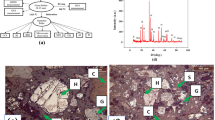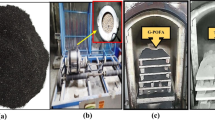Abstract
In the present investigation, boric acid was used in the ball formation of iron ore fines to improve the compressive strength (CS) of fired pellet. Boric acid was used in combination with carboxymethyl cellulose (CMC) and saw dust and the pellets were fired at different firing temperatures from 1000 to 1300 °C. Box–Behnken statistical design was followed for analyzing the CS at different levels of boric acid, CMC and firing temperature. Results were discussed using 2D surface plots. Response function predictions determined by the regression analysis showed coefficient of correlation (R2) for CS as 0.96. Highest CS of 450 kg/pellet was obtained with addition of 1% boric acid, 0.1% CMC and a temperature of 1300 °C within the range of parameters under investigation.








Similar content being viewed by others
References
Singh G P, Sundeep, Choudhary R P, Vardhan H, Aruna M, Akolkar A B, Proc Earth Planet Sci 11 (2015) 582.
Rathor N S, Beneficiation & Pelletization of Iron Ore to Suit Indian Conditions, Paper Presented at 10th Iron & Steel Summit 2012, p 44.
Dey S, Mohanta M K, Goswami M K, Pani S, J Miner Mater Charact Eng 2 (2014) 513.
Thella J S, Venugopal R, Powder Technol 211 (2011) 54.
Collins R J, and Ciesielski S K, Recycling and Use of Waste Materials and By-Products in Highway Construction National Cooperative Highway Research Program Synthesis of Highway Practice, vol 199, Transportation Research Board, Washington (1994).
Tsukerman T, Duchesne C, Hodouin D, Int J Miner Process 83 (2007) 99.
Meyer K, Pelletizing of Iron Ores, Sprinter, Berlin, 1980.
Sadrnezhaad S K, Ferdowsi A, Payab H, Comput Mater Sci 44 (2008) 296.
Ljung A-L, Staffan Lundström T, Daniel Marjavaara B, Tano K, Int J Heat Mass Transf 54 (2011) 3882.
Eisele T C, Kawatra S K, Miner Process Extr Metall Rev 24 (2003) 1.
Forsmo S P E, Apelqvist A J, Björkman B M T, Samskog P -O, Powder Technol 169 (2006) 147.
Sivrikaya O, Arol A İ, Int J Miner Process 110–111 (2012) 90.
de Souza R P, de Mendonca C F, Kater T, Min Eng Magn 36 (1984) 1437.
Kater T, Steeghs H R G, Organic Binders for Iron Ore Pelletization, 57th Annual Meeting of the Minnesota Section of AIME, Duluth-MN, USA, 13 (1984) p 1.
Heerema R H, Kortmann H, Kater T, ven den Boogaard V C, Improvements of Acid, Olivine and Dolomite Fluxed Iron Ore Pellets Using an Organic Binder, 5th International Symposium on Agglomeration, Brighton, 227 (1994).
Author information
Authors and Affiliations
Corresponding author
Rights and permissions
About this article
Cite this article
Kumar, S., Suman, S.K. Compressive Strength of Fired Pellets Using Organic Binder: Response Surface Approach for Analyzing the Performance. Trans Indian Inst Met 71, 1629–1634 (2018). https://doi.org/10.1007/s12666-018-1297-9
Received:
Accepted:
Published:
Issue Date:
DOI: https://doi.org/10.1007/s12666-018-1297-9




